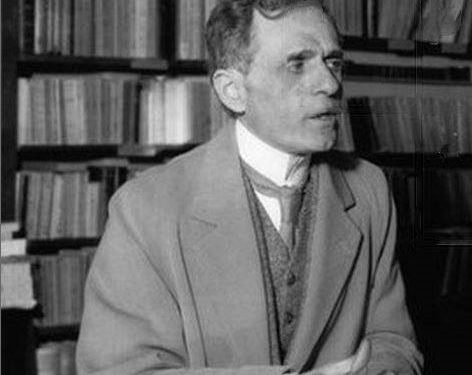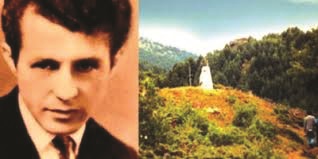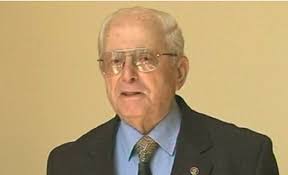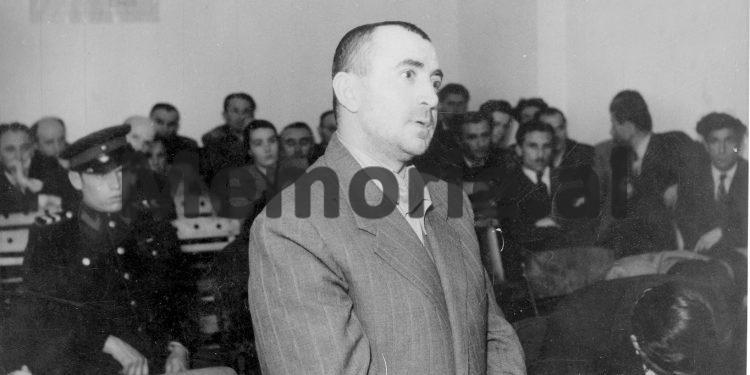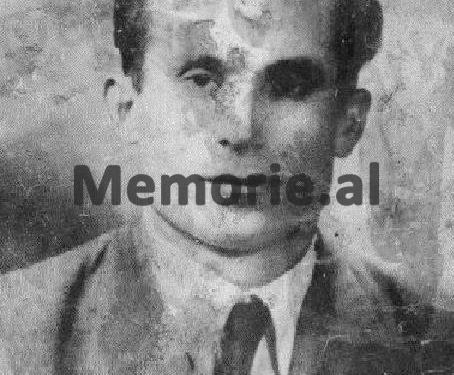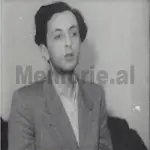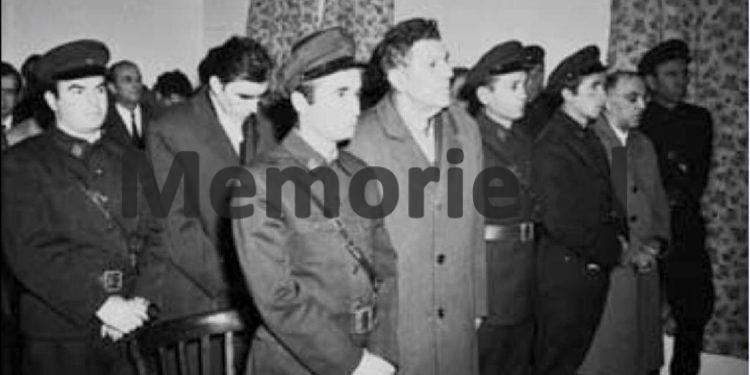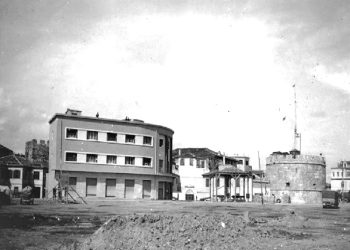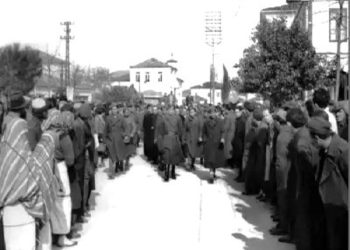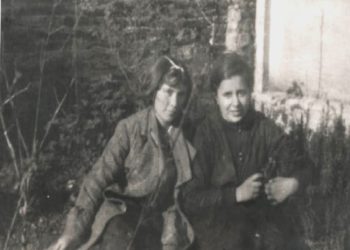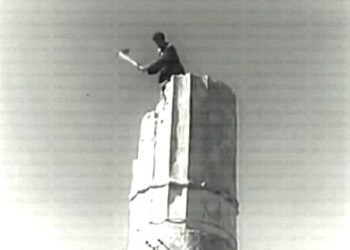From Agim Musta
Part twenty-eight
Memorie.al / On the fourth anniversary of the passing away of the well-known historian, researcher, writer and publicist Agim Musta, (July 24, 2019), former political prisoner, his daughters Elizabeta and Suela, gave him the right to exclusivity for the publication, by the online media Memorie.al, of one of the author’s most prominent publications, such as the ‘Black Book of Albanian Communism’. This work contains numerous data, evidence, facts, statistics and arguments unknown to the general public, on communist crimes and terror in Albania, especially against intellectuals, in the period 1945-1991. The publication for the first time of parts of this book is also the realization of one of the bequests of the historian Agim Musta, who, from the beginning of 1991 until he passed away, for nearly three decades was engaged with all his powers, working to raise collective memory, through book publications and publications in the daily press. All that voluminous work of Mr. Agim Musta, concretized in several books, is a contribution of great value to the disclosure of the crimes of the communist regime of Enver Hoxha and his successor, Ramiz Alia. A good part of the publications of Mr. Agim Musta, is also translated into English. Thanking the two daughters of the late Musta, who chose Memorie.al, to commemorate their father, from today we are starting the publication, part by part, of the “Black Book of Albanian Communism”.
Continues from last issue
(1945-1991)
Overseas Security Killings
As early as the summer of 1944, the Albanian communist security recruited corrupt elements in the Albanian armed forces and in the “Balli Kombëtar” and “Legaliteti” organizations, who were ready to kill their own fathers for money. A part of these elements, with very secret orders, they allegedly escaped from the partisan ranks and joined the shattered forces of the Front and Legality, who left Albania at the end of 1944. They were placed in emigrant camps in southern Italy and Greece. The book “The History of Albania”, published in 1984, claims that in 1951 alone, the Albanian State Security organized 135 actions against anti-communist elements inside and outside the country, resulting in 144 deaths.
Usually, elements active against the government of Tirana, prominent anti-communist politicians, fighters sent by foreign intelligence and people who enjoyed reputation inside and outside the borders of Albania were destroyed. Until the end of 1948, actions for the elimination of Albanians abroad were organized with the help of Yugoslav intelligence, while starting from 1949, until 1961, every action outside Albania and inside it was done through advisers of the Soviet KGB. The Albanian State Security played the role of the ordinary killer, while the diabolical projects and plans in such actions were prepared by the Soviet Intelligence advisers.
In the United States of America on December 3, 1949, the Chairman of the “Committee of Free Albania”, Mit’hat Frashëri, who had just arrived from France, was found dead in his room at the “Vonthrop” hotel in New York. It is said that Mit’hat Frashëri died through poisonous gas thrown from the keyhole in the room where he slept. This suspicion is confirmed by the American FBI, through Colonel Lok. In the United States of America, Ahmet Kuka with the pseudonym “Ariu”, one of the leaders of the most successful subversive groups, who came several times to Albania in the area of Labëria, was also eliminated by the Albanian Security. Likewise, the former Albanian weightlifting champion Aleksandër Kondo, who escaped from Albania in 1985, was eliminated with a car “accident” in 1986.
In Damascus, Syria, the former commander of the Battalion of the “National Front” of Kavaja, Mr. Liman Karuli and former deputy commander of the Tirana Police, Mr. Man Kukaleshi, who knew many “secrets” about the leaders of the Albanian Communist Party.
In Greece, Izet Vrazhdua, one of the commanders of the nationalist forces of Labëria, who came many times to Albania with anti-communist missions, was killed by poisoning in the early 60s. In New Zealand, Islam Kulla, the son of Begë Kulla from Turan i Korça, who fought heroically with the communist forces of the First Brigade, during the years 1943-1944, was annihilated in the 70s. In Chicago, United States of America, the anti-communist writer Bilal Xhaferi, who escaped from Albania in 1968, was mysteriously destroyed in 1986. After several failed assassination attempts on Bilal Xhaferi, the Albanian Security finally found a way to disappear of him, poisoning him in a hospital where he was admitted for treatment.
In 1982, the Albanian security poisoned the wife of Mr. Sabaudin Haznedari, who committed suicide that same year in the city of Rrogozhina, where he had come together with Xhevdet Mustafa. On September 8, 1984, the young Ilir Pavllo was killed in a Belgrade hotel by the Albanian Security, after he had given an interview on a television show on Titograd TV, after escaping from Albania.
According to the statement of the former general of the Albanian Sigurimi, Halim Xhelo, imprisoned and suspended in the prison hospital of Tirana, by the Albanian Sigurimi, about 50 people have been annihilated abroad. These murders are covered with a fog, that only the opening of the archives of the former Ministry of Internal Affairs of Albania can shed light on those mysterious murders.
War within the communist type
The Italian thinker, Francesco Niti, says that communists are terrorized terrorists. Someone else says that communism was like Kronos of Greek Mythology, who fed by eating his own sons. This has been fully proven in the history of the Albanian Communist Party, which was the last to be founded in Europe. The murders within the species started right after the creation of the Albanian Communist Party, on November 8, 1941. The series of murders against the leaders of the Communist Party began with the murder of Qemal Stafa, Secretary of the Albanian Communist Youth, on May 5, 1942.
From all the data published by the press of the time during the period 1991-2006, there is no doubt that Qemal Stafa was destroyed by denunciation to the fascist bodies, by the leadership of the Albanian Communist Party of that time. One of the first communists, Zef Ndoja, was executed and mysteriously killed in 1943, in whose house the archive of the Communist Party was kept. One of the leaders of the Communist Youth Group, Anastas Lula (“The Crow”) was killed in the back in Glavë i Tepelena in 1944, likewise in 1944, one of the leaders of the Communist Party was killed in the back in the battle of Kruja , Mustafa Kaçaçi.
In 1944, one of the leaders of the communist war, Mustafa Gjinishi, was mysteriously killed in the district of Dibra. In Vlora, one of the leaders of the Communist Party of the district, Neki Ymeri, is killed by his friends without any motive. In 1947, one of the leaders of the guerrilla units of Tirana, from the period 1942-1944, ex-major of the Communist Security, Galip Hatibi, was destroyed by burning him in the boiler of the Ministry of Internal Affairs.
In 1946, the creator of the first Albanian communist party, founded in 1937, the teacher Hasan Reçi, was killed. The creators of the communist groups of Korça, Andrea Zisi and Aristidh Qendro, were executed after being previously sentenced by the court, with 10 years of imprisonment. In 1947, a member of the Political Bureau, one of the leaders of the Albanian Communist Party during the war, the chairman of the State Plan Commission, Nako Spiru, was found murdered in his office.
On December 2, 1948, he was arrested:
- Koci Xoxe, former first deputy prime minister and Minister of Internal Affairs, from 1945-1948.
- Pandi Kristo, former minister.
- Vaskë Koleci, Director of State Security and Deputy Minister of Internal Affairs.
- Vangjo Mitrojorgji, Director of Security for Tirana.
- Nuri Huta, director of propaganda at the Ministry of Internal Affairs.
All the crimes committed by the Albanian Communist Party, until that time, were billed to this group. Koçi Xoxe was sentenced to death and executed on June 11, 1949, while the others were sentenced to heavy prison terms. In 1951, Njazi Islami, the candidate of the Central Committee and former minister, was killed. It was said that he killed himself! In 1951, Sali Ormëni, former deputy minister of the Interior, was found murdered near Elbasan. At first it was said that he had killed himself, as he regretted that he had left to escape to Yugoslavia! In 1954, when Mehmet Shehu was appointed Prime Minister, he encouraged Enver Hoxha to assassinate Tuk Jakova, former Deputy Prime Minister and member of the Political Bureau.
Together with Tuk Jakova, former minister Bedri Spahiu, the only critic of Enver Hoxha in the Central Committee of the Labor Party, was expelled from the Political Bureau. In 1957, Tuk Jakova and Bedri Spahiu were sentenced, the first with 20 years of imprisonment and the second with 25 years of imprisonment. Tuk Jakova, (according to the witness in the trial of Kadri Hazbiu), the composer Dhora Leka, was poisoned in 1959, in the hospital-prison of Tirana, by order of Mehmet Shehu.
In 1964, General Gjin Marku, a former member of the Communist Party’s National Committee, was arrested and sentenced to 10 years in prison. Gjin Marku is re-sentenced to 10 years in prison and dies in Burrel prison. In 1960, one of the most capable generals of the Albanian Communist Security, Hilmi Seiti, a close friend of Rear Admiral Teme Sejko, was poisoned because he refused to take over the role played by Teme Sejko in the conspiracy concocted by Enver Hoxha, Mehmet Shehu and Kadri Hazbiu.
In 1966, the former general of the State Security, Halim Xhelo, was sentenced to 15 years in prison and was later found hanged in the prison-hospital of Tirana. In 1956, the Conference of the Labor Party (Communist) was organized in Tirana for the capital, which would precede the Third Congress of the Party. Enver Hoxha, with his wife Nexhmies, who was a close collaborator in state and party affairs, organized with naive elements in the Conference, a debate against the cult of the individual, under the example of the Soviet Communist Party, directed at that time from Nikita Khrushchev.
The debate at the Tirana Conference, unexpectedly and without recall, went outside the framework organized by Nexhmije Hoxha and took on frightening proportions for the power of Enver Hoxha. He came urgently to the Conference, interrupting the holidays he was spending in Vlora and with an “iron club” in his hand, he hit many cadres of the party-state, such as; Pajo Islamin, Vehip Demin, Ihsan Budo, etc., who were arrested, brought before a court behind closed doors and sentenced to prolonged imprisonment and exile. Similarly, in 1956, Liri Gega, former member of the Political Bureau of the Albanian Communist Party, Dali Ndreu, general and commander of the First Corps and Petro Bollati, former director of the Shkodra District Security, were brought before a military court. . All three were sentenced to death and executed within the week.
On May 27, 1961, a group of party-state cadres were sentenced to death together with Teme Sejko. In 1973, the ideologues of the Labor Party, members of the Central Committee, Fadil Paçrami and Todi Lubonja, were sentenced to heavy prison terms. It was time that the dictator Hoxha had suffered a stroke (cerebral hemorrhage) and in the high party circles, rival groups were being formed to take power in their hands after the death of the dictator. The most powerful group was that of the legitimate heiress, Nexhmije Hoxha (Xuglini), who had on her right wing her intimate friend from her youth, the member of the Political Bureau, Ramiz Alina, who was rumored to be the head of the Enver Hoxha’s secret police.
Another powerful group was the clan of Prime Minister Mehmet Shehu, led by Kadri Hazbiun and a bunch of former generals of the Ministry of Internal Affairs. The third grouping, less homogeneous and less politically prepared for the governance of the country, was the military one, headed by the Minister of Defense, Begir Balluku. The third faction had an advantage that the first two factions did not have, they commanded an army armed to the teeth and blindly obedient to their orders.
In the event of the dictator’s death, the third group could intervene against his rivals to take power through a military coup. The group of Nexhmije Hoxha and Mehmet Shehu smelled this danger, and although they were stabbing each other in the back, they joined on this occasion to destroy the military group.
In 1974, with the most absurd accusations that could exist, the Ministry of Defense was hit, sentencing to death the Minister Beqir Balluku, the Chief of Staff of the Army, former General Petrit Dume, and the Director of the Political Directorate, former General Hito Çako . Dozens of senior officers were imprisoned and several hundred were released. Among those sentenced to heavy prison terms were:
- Rrahman Parllaku, former Deputy Minister of Defense
- Sadik Bekteshi, former Deputy Minister of Defense
- Vaskë Gjino, general
- Arif Hasko, general
- Abaz Fejzo, general
- Ernest Jakova, general
- Sulo Kozeli, general
- Muhamet Prodani, general
- Oedip Ohri, colonel
Many of whom lost their lives in Burrel prison, such as Abaz Fejzo, Vaskë Gjino, etc. After the elimination of the military group, in 1975 the members of the “Economic Group” were arrested and hit with the “sword of Damocles” by Enver Hoxha, which included former deputy prime ministers Abdyl Këllezi and Koço Theodhosi. Apart from them, this group also included ministers Kiço Ngjela and Vasil Kati. Two deputy prime ministers were sentenced to death and executed, while Kiço Ngjela and Vasil Kati were sentenced to heavy penalties.
With the “Economic Group”, they also complicit the member of the Central Committee and secretary of the Party Committee for the district of Fier, Pirro Gusho, who was said to have killed himself. Another eliminated personality was Koço Tashko, the Comintern’s envoy to Albania, since 1937. Chairman of the Party’s Revision Control. He was arrested in 1961 and sentenced to 10 years in prison. After being released from prison, he dies in exile at Thumana’s farm.
After the elimination of the above groups, invisible arrows were directed against Mehmet Shehu’s clan. According to the assertions of his personal guard, Ali Cenos, and Mehmet’s own son, Bashkimi, Mehmet was put under constant and almost open surveillance by the main Nexhmije-Ramiz group. His every movement and conversation was recorded and controlled. The former prime minister lived in a state of anxiety. Only one thing could save Mehmet Shehu, the death of Enver Hoxha.
Then the way for the chairman of the party-state was open and his revenge against the Nexhmije-Ramiz clan would be bloody and no one could stop him. The prediction of an English medical professor, who had come to Tirana in a very secret way, that the dictator Hoxha would not have a quick death, but his nervous system would always be irritated and woe to those around him, was confirmed. completely.
It is true that in moments of enlightenment, Enver Hoxha gave directives for the work of the state and the party and for the annihilation of those who he predicted would be dangerous after his death. The methods and traps were elaborated by the Nexhmije-Ramiz binomial. This is how they set the trap for Mehmet Shehu, the former Prime Minister of Albania for 27 years. About his death on December 17, 1981, there are several variants, but the most reliable are:
1) Mehmet Shehu was poisoned by his wife, Fiqrete Shehu (Sanxhaktari), who was promised not to touch her and the boys after Mehmet’s elimination, if Fiqiretja took over this task, which the party assigned to her, as she was fully “proven” that Mehmet Shehu was a political agent of the Revisionist Imperialist Powers. The official statement of the party-state, which was announced on December 18, said that Prime Minister Mehmet Shehu killed himself in a moment of nervousness.
2) Mehmet Shehu was destroyed by his right wing, Kadri Hazbiu, who had smelled that their group was expected to be hit from day to day. He betrayed Mehmet Shehu and undertook his execution.
3) Mehmet Shehu, killed himself on the night of December 17, 1981, after the destructive criticisms that were made to him in the party plenum and Enver Hoxha’s refusal to meet him that night. Just like a scorpion that surrounds itself with fire, stings itself and destroys itself, so did the sadist Mehmet Shehu, commit suicide.
After the murder of Mehmet Shehu, the former Minister of Internal Affairs, Feçor Shehu, the former Minister of Health, Llambi Zeçishti, the former Minister of Foreign Affairs, Nesti Nase, and many senior officials of the Ministry of Works were arrested and sentenced to death. of the Interior, such as Llambi Peçini, Bato Karafili, Mihallaq Ziçishti, Idriz Seiti, etc. The circuit of this vicious circle was closed by the execution of Kadri Hazbiu in 1983. The terrorist communists started and ended their lives with blood. Memorie.al
The next issue follows




